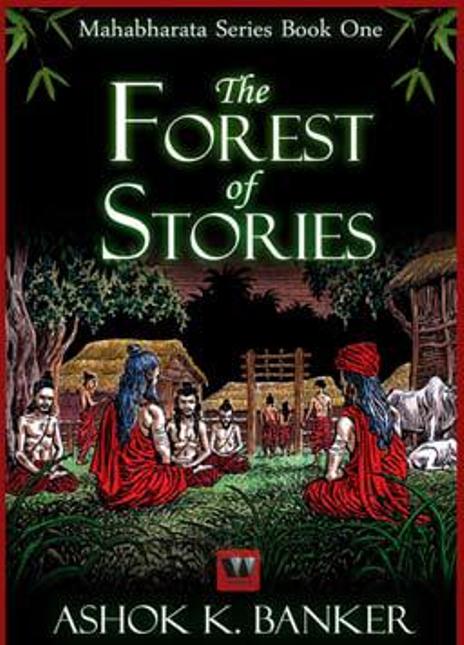by Vibha Sharma
[box]Ashok K. Banker’s ‘The Forest of Stories’ is a must-read, suggests Vibha Sharma. Banker not just narrates the stories; rather, he adorns them beautifully with drama and action while keeping it simple and contemporary for the new generation, she says.[/box]Title : The Forest of Stories
Author : Ashok K. Banker
Publisher : Westland
ISBN : 978-93-81626-37-5
I have always enjoyed reading the retellings of one of the greatest epics of the world – the Mahabharata. In keeping with this urge to experience diverse perspectives on the epic, how could I skip reading Ashok Banker’s take on this grand drama? Ashok K Banker has earned a repute of being one of the best in this particular genre with his engaging Ramayana series followed by the Krishna Coriolis Series.
‘The Forest of Stories’ by Ashok Banker is a bit like the groundwork before the actual magnum opus. The way Banker has presented the stories in fine detail makes one guess that this particular series is going to be a long one. In fact, if I have the correct information, there are 17 more books to follow ‘The Forest of Stories’!

Reading through this book, I realised that I am familiar with some of the stories that are narrated in it; however, many are completely new to me. As Banker rightly points out, all these stories interconnect at some point like small tributaries meeting and merging with other tributaries, finally draining into the main river.
This set of stories is narrated by Ugrasrava , son of Lomarsana. Ugrasrava is fondly called ‘Sauti’ because he is a ‘Suta’, the son of a Kshatriya father and a Brahmin mother. The epic begins when, after a long and strenuous journey, Sauti reaches Naimisha-van, where Kulapati Shaunaka and his many acolytes practice their austere rituals in an ashram. It is the same place where the great historical Kurukshetra battle was actually fought and history was created. It is a pleasure for the ashramites and inhabitants of the forest to listen to the narration of Mahabharata from Sauti, as he had the privilege of listening to the recitation from the creator of the epic, Vyasa, himself. Surprisingly, Sauti’s audience expands every day and it is as though the entire Naimisha-van is listening, each tree representing a dead soul in the Kurukshetra war. They are curious about the events that led to the great war, which led to their demise.
Here Banker very beautifully explains and justifies the presence of these silent listeners by saying, “If there is one question that has always haunted the human mind, it is this: What is the point of living? What is our purpose here on earth? Why were we put here on this mortal planet? Is there a larger plan? All humans come back to the same question: Why are we here?
“It was a question that everyone hoped the great epic Mahabharata would answer. After all, it was called the Fifth Veda for good reason. It not only told a great tale, but illuminated the essence of the human condition through the events of that great tale. And no question was more essential to the human condition than knowing why one existed.”
‘The Forest of Stories’ presents an array of seven interesting stories that does not involve any of the main characters of the great battle. There is the tale of Parashuram and his vow to cleanse the earth of the Kshatriyas not just once but 21 times. The story of Parikshat’s son – Janamajaya, who conducts a great yagna so that all snakes of the world including King Takshaka get engulfed in the flames of the yagna and get wiped off the face of earth, also finds a place. Then there is a story of Sage Bhrigu and his wife Puloma, which leads to the story of Dushyanta and Shakuntala. Except Parashuram’s and Shakuntala’s stories, the rest were completely new to me. And of all the tales presented in this book, the story of Parshuram definitely scores over the rest, riding high on the brilliant descriptive style of the author.
Banker has maintained the authenticity of the facts by adhering to Vyasa’s text very closely and has enhanced the overall effect by his signature flair for making scenes come alive in regal grandeur. Banker not just narrates the stories; rather, he adorns them beautifully with drama and action while keeping it simple and contemporary for the new generation. His linguistic skills are par excellence and it is a delightful experience to just fly on the beautiful words of the author to the enchanting world, unraveling the mysteries of the mythological era that he describes in the pages of this book.
If you ever get overwhelmed while reading various stories and meeting the innumerable characters entering and exiting the stage, do keep this in mind – “As you hear the stories unfold, their connections will become amply clear to your enlightened mind and you will enjoy the beauty of this great narrative of Sage Krishna Dweipayana Vyasa. For it is a masterpiece of itihas, containing all the devices of poetics and aesthetics employed in their finest grain.”
After reading this book, I now look forward to reading the rest of Ashok Banker’s ‘MBA series,’ and I am sure there are many more readers who are committed to do so too. It is also interesting to read how The Mahabharata became Banker’s MBA. So don’t miss it!
Vibha Sharma regularly reviews books in her blog http://literarysojourn.blogspot.com/
[facebook]Share[/facebook] [retweet]Tweet[/retweet]






I have always enjoyed reading Ashok Banker’s books. I grew up in a house where the epics were told and retold, but his books manage to give a completely different perspective to the stories which i know so well… which is why I enjoy them. I have his Ramayana series at home, and have also read his Krishna coriolis, but i have yet to get my hands on the Mba series… this review makes me want to read them soon!